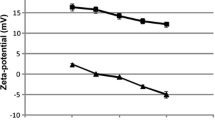Abstract
In this study, we developed a drug delivery system (DDS) using polymeric nanocarriers for the treatment of biofilm infection disease. Clarithromycin (CAM)-encapsulated and chitosan (CS) modified polymeric nanoparticles (NPs) were prepared using a polyvinyl caprolactam—polyvinyl acetate—polyethylene glycol graft copolymer (Soluplus®) (Sol) and poly-(DL-lactide-co-glycolide), respectively. To understand the availability of the prepared NPs, we made morphological observations of the antibacterial activity derived from the NPs toward the bacterial cells within the biofilm using scanning electron microscopy and transmission electron microscopy measurements. These results revealed different antibacterial activities for the two types of drug carriers. In the case of CAM-encapsulated + CS-modified Sol micelles treatment, NPs can exert their antibacterial activity not only by the surfactant, CAM and CS effects but also by intrusion into the bacterial cells. Thereby, CAM-encapsulated + CS-modified Sol micelles had a higher antibacterial activity. The morphological information is useful to design suitable NPs for the treatment against biofilm infections.



Similar content being viewed by others
References
O’Toole G, Kaplan HB, Kolter R (2000) Biofilm formation as microbial development. Annu Rev Microbiol 54:49–79
Donlan RM (2001) Biofilm formation: a clinically relevant microbiological process. Clin Infect Dis 33:1387–1392
Offenbacher S, Barros SP, Singer RE, Moss K, Williams RC, Beck JD (2007) Periodontal disease at the biofilm-gingival interface. J Periodontol 78:1911–1925
Wu H, Moser C, Wang HZ, Høiby N, Song ZJ (2015) Strategies for combating bacterial biofilm infections. Int J Oral Sci 7:1–7
Ramazani F, Chen W, van Nostrum CF, Storm G, Kiessling F, Lammers T, Hennink WE, Kok RJ (2016) Strategies for encapsulation of small hydrophilic and amphiphilic drugs in PLGA microspheres: state-of-the-art and challenges. Int J Pharm 499:358–367
Kawashima Y, Yamamoto H, Takeuchi H, Hino T, Niwa T (1998) Properties of a peptide containing DL-lactide/glycolide copolymer nanospheres prepared by novel emulsion solvent diffusion methods. Eur J Pharm Biopharm 45:41–48
Yamamoto H, Tahara K, Kawashima Y (2012) Nanomedical system for nucleic acid drugs created with the biodegradable nanoparticle platform. J Microencapsul 29:54–62
Takahashi C, Ogawa N, Kawashima Y, Yamamoto H (2015) Observation of antibacterial effect of biodegradable polymeric nanoparticles on Staphylococcus epidermidis biofilm using FE-SEM with an ionic liquid. Microscopy 64:169–180
Takahashi C, Saito S, Suda A, Ogawa N, Kawashima Y, Yamamoto H (2015) Antibacterial activities of polymeric poly (DL-lactide-co-glycolide) nanoparticles and Soluplus® micelles against Staphylococcus epidermidis biofilm and their characterization. RSC Adv 5:71709–71717
Yang YQ, Zheng LS, Guo XD, Qian Y, Zhang LJ (2011) pH-Sensitive micelles self-assembled from amphiphilic copolymer brush for delivery of poorly water-soluble drugs. Biomacromolecules 2:116–122
Yokoyama M, Okano T, Sakurai Y, Ekimoto H, Shibazaki C, Kataoka K (1991) Toxicity and antitumor activity against solid tumors of micelle-forming polymeric anticancer drug and its extremely long circulation in blood. Cancer Res 51:3229–3236
Setou M, Radostin D, Atsuzawa K, Yao I, Fukuda Y, Usuda N, Nagayama K (2006) Mammalian cell nano structures visualized by cryo Hilbert differential contrast transmission electron microscopy. Med Mol Morphol 39:176–180
Hyo Y, Yamada S, Harada T (2008) Characteristic cell wall ultrastructure of a macrolide-resistant Staphylococcus capitis strain isolated from a patient with chronic sinusitis. Med Mol Morphol 41:160–164
Takahashi C, Kalita G, Ogawa N, Moriguchi K, Tanemura M, Kawashima Y, Yamamoto H (2015) Electron microscopy of Staphylococcus epidermidis fibril and biofilm formation using image-enhancing ionic liquid. Anal Bioanal Chem 407:1607–1613
Wilkes JS, Zaworotko MJ (1992) Air and water stable 1-ethyl-3-methylimidazolium based ionic liquids. J Chem Soc Chem Commun 13:965–967
Chiappe C, Pieraccini D (2005) Ionic liquids: solvent properties and organic reactivity. J Phys Org Chem 18:275–297
Kuwabata S, Kongkanand A, Oyamatsu D, Torimoto T (2006) Observation of ionic liquid by scanning electron microscope. Chem Lett 35:600–606
Takahashi C, Shirai T, Fuji M (2013) FE-SEM observation of swelled seaweed using hydrophilic ionic liquid; 1-butyl-3-methylimidazolium tetrafluoroborate. Microsc Res Tech 76:66–71
Takahashi C, Pattanayak DK, Shirai T, Fuji M (2013) Solvent effect on observation of nanostructural hydrated porous ceramic green bodies using hydrophilic ionic liquid. RSC Adv 4:27322–27328
Sanada Y, Akiba I, Sakurai K, Shiraishi K, Yokoyama M, Mylonas E, Ohta N, Yagi N, Shinohara Y, Amemiya Y (2013) Hydrophobic molecules infiltrating into the poly(ethylene glycol) domain of the core/shell interface of a polymeric micelle: evidence obtained with anomalous small-angle X-ray scattering. J Am Chem Soc 135:2574–2582
Takahashi C, Muto S, Yamamoto H (2016) A microscopy method for scanning transmission electron microscopy imaging of the antibacterial activity of polymeric nanoparticles on a biofilm with an ionic liquid. J Biomed Mater Res B (in press)
Kakegawa T, Ogawa T, Hirose S (1988) Mode of inhibition of protein synthesis by TE-031. Chemotherapy 36:123–128
Kondoh K, Hashiba M, Baba S (1996) Inhibitory activity of clarithromycin on biofilm synthesis with Pseudomonas aeruginosa. Acta Otolaryngol Suppl 525:56–60
Dutta PK, Tripathi S, Mehrotra GK, Dutta J (2009) Perspectives for chitosan based antimicrobial films in food applications. Food Chem 114:1173–1182
Greenwood D, O’Grady F (1972) Scanning electron microscopy of Staphylococcus aureus exposed to some common anti-staphylococcal agents. J Gen Microbiol 70:263–270
Banat IM, De Rienzo MA, Quinn GA (2014) Microbial biofilms: biosurfactants as antibiofilm agents. Appl Microbiol Biotechnol 98:9915–9929
Friedrich CL, Moyles D, Beveridge TJ, Hancock RE (2000) Antibacterial action of structurally diverse cationic peptides on gram-positive bacteria. Antimicrob Agents Chemother 44:2086–2092
Mitchell P, Moyle J (1957) Autolytic release and osmotic properties of ‘Protoplast’ from Staphylococcus aureus. J Gen Microbiol 16:184–194
Acknowledgments
This study was partially supported by JSPS KAKENHI Grant Numbers 25460046, 50574448 and NIMS microstructural characterization platform as a program of “Nanotechnology Platform” of the Ministry of Education, Culture, Sports, Science and Technology (MEXT), Japan. The authors are grateful to Prof. S. Yamada, of Kawasaki Medical University, Japan and Prof. Y. Nishiyama, of Teikyo University, Japan for useful discussions regarding TEM observation.
Author information
Authors and Affiliations
Corresponding author
Electronic supplementary material
Below is the link to the electronic supplementary material.
Rights and permissions
About this article
Cite this article
Takahashi, C., Akachi, Y., Ogawa, N. et al. Morphological study of efficacy of clarithromycin-loaded nanocarriers for treatment of biofilm infection disease. Med Mol Morphol 50, 9–16 (2017). https://doi.org/10.1007/s00795-016-0141-8
Received:
Accepted:
Published:
Issue Date:
DOI: https://doi.org/10.1007/s00795-016-0141-8




